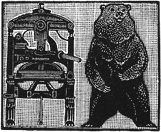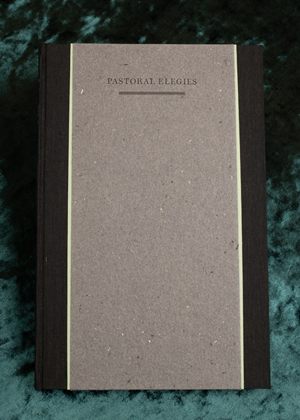| |
||||||||
Books in Print

Wood engraving by Colin Paynton
(from The Chimes, 1985)
Weathers:
A Selection of Thomas Hardy’s Poems
October 2025
Loose Canons Two:
E A Robinson: Ben Jonson Entertains a Man from Stratford & Other Poems
February 2025
Loose Canons Three:
Edward Thomas: The Child on the Cliffs
April 2025
Loose Canons Four:
Merrill Moore: Blue & Yellow Evening at Ostend
October 2025
Pastoral Elegies
Thomas Gray’s
Elegy written in
a country churchyard
& Oliver Goldsmith’s
The Deserted Village
Spring 2024
|
Click on book cover |
Pastoral Elegies
Thomas Gray’s ‘Elegy written in a country churchyard’
& Oliver Goldsmith’s ‘The Deserted Village’
With 10 wood engravings by Christopher Wormell
Spring 2024
Our subscribers and those who follow our trail will know that one of our chief delights is the revival of works from the canon of poetry in English. We have published work by several poets over the years in this area – Spenser, Keats, Clough, Shakespeare, and of course the inimitable Thomas Ingoldsby. We have published more contemporary poetry in the last few years – by Robert Bringhurst, Molly Holden, Jan Zwicky, and C P Cavafy – and our last dips into the canon date back to 2017 (Musick in partes: Songs & Poems from the plays of William Shakespeare) and 2015 (Fancy: 8 Odes of John Keats). It’s time to explore it again. Up to now we have kept to the renaissance and the 19th century. Now, for the first time, we are moving into the Augustan realm of the 18th century.
Gray’s ‘Elegy’ and Goldsmith’s ‘The Deserted Village’ are two of the most celebrated poems of the period. Goldsmith’s poem, first published in 1770, particularly aroused considerable debate. It was read principally as both an argument against the Enclosures Act and a description of the displacement by wealthy landowners of the rural populations of farmers and workers on the land. Some of those displaced moved to the rapidly growing cities, others emigrated to America – both circumstances mentioned in Goldsmith’s poem – but the consequence of both was to initiate the gradual destruction of the traditional English rural lifestyle. Some disavowed this argument, while others embraced it fervently – particularly in the 19th century in the wake of Malthusian theory. Goldsmith had himself seen an example of this upheaval in 1761, when the village of Nuneham Courtenay in Oxfordshire – generally accepted as the model for Goldsmith’s ‘Sweet Auburn’ – was forcibly razed by the 1st Earl Harcourt and its inhabitants re-sited a mile and a half away, in order to allow for the creation of a luxurious landscape garden by ‘Capability’ Brown. (Goldsmith had written a polemical essay at the time, ‘The Revolution in Low Life’, whose geographical description fits Nuneham Courtenay very closely.) Although Goldsmith describes the village of Auburn and its people with affecting particularity, he deliberately avoids direct references to a defined place, in order that the poem may be read as a metaphorical depiction of an acknowledged phenomenon.
However, ‘The Deserted Village’ is not essentially a polemic, but a lament for the disappearance of village life resulting from the enforced shift of large proportions of the population into urban industrial centres, which required a complete reassessment of their lives that most were incapable of addressing. Dickens was only the best known writer to excoriate the results of this development; the passages in The Old Curiosity Shop set in the inferno of the Potteries are perhaps the most scathing of all his attacks on the destruction of the country by industrial concerns, but all his novels are filled with the poor and the desperate to be found in the streets of England’s great cities, particularly London. Gaskell’s North and South is another, perhaps more measured, attack. Despite the wrongs which overshadow the background of the poem, ‘The Deserted Village’ remains one of the most poignantly affecting descriptions of old village life in the canon, equalled only by John Clare in ‘The Shepherd’s Calendar’ (1827).
Thomas Gray’s ‘Elegy written in a country churchyard’, first published in 1751, is one of the most resolutely popular and frequently quoted of all English poems. In its earliest drafts from 1742 it is thought to have been written in response to the death of the now unknown poet Richard West, whom Gray knew, and in whose memory he composed other shorter poems at the time. Gray revived these incomplete drafts in 1750, restructured them, and completed the poem, though not then as a specific elegy for West or any one person, but as a meditation on mortality, particularly of any who ‘blush unseen, / And waste [their] sweetness on the desert air.’ It is to an extent an elegy on his own life, and expresses a concern, one he feels to be universally part of the human condition, about the legacy each of us may leave, or whether we are bound to disappear into obscurity. It is, in that sense, an elegy for Everyman, that paradoxically omnipresent but forgotten figure of western culture, who is at the same time one of its glories.
Ours is by no means the first edition to place these two poems together. Particularly in the late Victorian period, from 1873 on, a number of such editions were published, and in 1896 a reputable journal of the time, The Academy, declared that ‘Gray’s “Elegy” and Goldsmith’s “The Deserted Village” shine forth as the two human poems in a century of artifice.’
Nor is ours the first to provide illustrations with the poems. Indeed the first editions of both poems appeared with illustrations, and while Goldsmith’s poem went on to be illustrated by Thomas Bewick and his students, Francis Wheatley, and the Dalziel Brothers (whose engravings appeared in our edition of The Ingoldsby Legends), Gray’s ‘Elegy’ was accompanied by pictures by no less than William Blake and John Constable, among others.
We feel very fortunate to have been able to collaborate with the English engraver Christopher Wormell for Pastoral Elegies. Chris has illustrated a number of books for the Folio Society, including Patrick O’Brian’s Joseph Banks: A Life and Gilbert White’s A Natural History of Selborne. He is also widely known as an illustrator of children’s books – usually with multicolour linocuts – and a creator of public art, such as the engravings marking various areas of interest at Hampton Court, the lion device for the Aston Villa Football Club, and the new arms for the Royal Opera House. His engravings for Goldsmith and Gray are atmospheric, haunting, and lovely, and we are delighted he has agreed to be part of the book.
![]()
Some Comments by Readers
I think you’ve done a superb job of the edition. I’m generally not the biggest fan of Moderns, but the use of Bell here is absolutely right and looks great. And the pairing with Fry’s ornamented gets the thumbs up too. ... [T]he illustrations could not be more perfect; that first page of Gray’s Elegy, with that incredible engraving of the cows, is beautiful, and as I leaf through I find myself of the mind that it beats the [Limited Editions Club] Agnes Miller Parker version quite comfortably. ... The binding of the edition is also very nicely designed. It’s a fresh way to have gone rather than some period pastiche ...
Mark Askam, Designer and Publisher
[Pastoral Elegies] is lovely, beautifully designed, and elegantly presented. The presswork is impeccable ... and the binding and [slipcase] and everything else reveals bookmaking at the highest level. I love this one. ... I particularly like the way the binding was done, and having the portfolio of separates gives this an air of exclusivity and ‘deluxity’ (a word I made up just for this book; maybe it’s a real word).
Sid Berger, Subscriber, Bibliographer, Professor of Library and Information Science and English; author of The Dictionary of the Book: A Glossary for Book Collectors, Booksellers, Librarians, and Others (2016), and many other titles – including a bibliographical whodunnit, The Book of Death (2017) Verbum sat sapienti!
![]()
SINGLE STATE: 135 copies. Small Crown quarto: 10 by 6 ½ inches [254 by 165mm]. 60 pages. Hand-set in Bell in green and black with Fry’s Ornamented for display on our last stock of (now unfortunately vintage) Zerkall ENE extra smooth mouldmade paper. Ten wood engravings by Christopher Wormell, all printed from the wood. Bound in half Japanese black silk and printed grey Canal paper printed with pale green Bugra bordering slips. Printed spine label. Slipcased with a portfolio of proofs of the engravings. PRICE: C$975.00.
RESERVATIONS are RECOMMENDED. Please contact the press.
